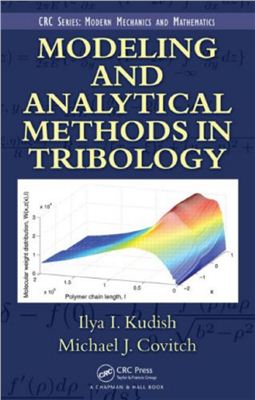CRC Press, 2010. - 925 Pages.
Improving our understanding of friction, lubrication, and fatigue, Modeling and Analytical Methods in Tribology presents a fresh approach to tribology that links advances in applied mathematics with fundamental problems in tribology related to contact elasticity, fracture mechanics, and fluid film lubrication. The authors incorporate the classical tenets of tribology while providing new mathematical solutions that address various shortcomings in existing theories.
From contact interactions to contact fatigue life, the book connects traditionally separate areas of tribology research to create a coherent modeling methodology that encompasses asymptotic and numerical techniques. The authors often demonstrate the efficacy of the models by comparing predictions to experimental data. In most cases, they derive equations from first principles. They also rigorously prove problem formulations and derive certain solution properties. Solutions to problems are presented using simple analytical formulas, graphs, and tables. In addition, the end-of-chapter exercises highlight points important for comprehending the material and mastering the appropriate skills.
Unlocking the secrets that gove the physics of lubricated and dry contacts, this book helps tribologists on their quest to reduce friction, minimize wear, and extend the operating life of mechanical equipment. It provides a real-world industrial perspective so that readers can attain a practical understanding of the material.
Improving our understanding of friction, lubrication, and fatigue, Modeling and Analytical Methods in Tribology presents a fresh approach to tribology that links advances in applied mathematics with fundamental problems in tribology related to contact elasticity, fracture mechanics, and fluid film lubrication. The authors incorporate the classical tenets of tribology while providing new mathematical solutions that address various shortcomings in existing theories.
From contact interactions to contact fatigue life, the book connects traditionally separate areas of tribology research to create a coherent modeling methodology that encompasses asymptotic and numerical techniques. The authors often demonstrate the efficacy of the models by comparing predictions to experimental data. In most cases, they derive equations from first principles. They also rigorously prove problem formulations and derive certain solution properties. Solutions to problems are presented using simple analytical formulas, graphs, and tables. In addition, the end-of-chapter exercises highlight points important for comprehending the material and mastering the appropriate skills.
Unlocking the secrets that gove the physics of lubricated and dry contacts, this book helps tribologists on their quest to reduce friction, minimize wear, and extend the operating life of mechanical equipment. It provides a real-world industrial perspective so that readers can attain a practical understanding of the material.

